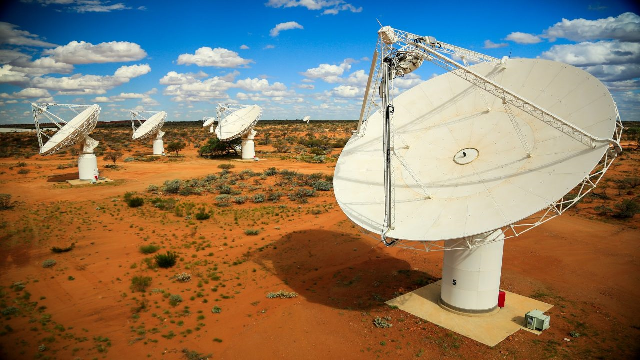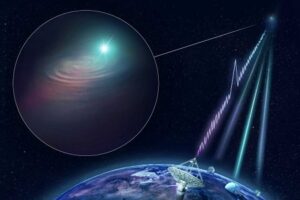Using the astronomy equivalent of a live action replay, an Australian team have tracked the source of a one-off fast radio burst to a galaxy 3.6 billion light years away.
This scientific article demonstrates the importance of technology in science and Australia’s contribution to science understanding. It would be well suited to Earth and Space, Physical and Chemical Sciences for years 5, 7, 8, 9, 10 and Senior Sciences.
Word Count / Video Length: 892 / 1:11 mins

For over a decade astronomers have hunted fast radio bursts – super-bright flashes of radiation that stream through space and last just a fraction of a second.
There have been some successes, such as tracking a repeating burst to its home galaxy. There have also been setbacks, including finding the similar perytons to be from the lab microwave oven.
But now an Australian-led team of astronomers has determined the precise location of a powerful one-off burst of cosmic radio waves.
“This is the big breakthrough that the field has been waiting for since astronomers discovered fast radio bursts in 2007,” says Keith Bannister, who led the research at the CSIRO. The team also included researchers from ICRAR and Swinburne University.
Indeed, the source of the one-off burst is very different to that of the repeating burst found in 2017, opening up a whole range of possibilities for one of the most mysterious signals in the cosmos.
Astronomical “Live action replay” catches an FRB
In the 12 years since the discovery of the first fast radio burst (FRB), a global hunt has spotted 85 of the bursts. Seeing then locating the source of FRB’s is one of the biggest challenges in astronomy. Their unpredictability and short duration – less than a millisecond – make it extremely difficult to accurately determine where they have come from.
“They’re extremely bright – so they release about as much energy in a millisecond that the sun does in 80 years… if one went off at the position of the Sun, you would pop popcorn on Neptune. So they’re extremely powerful events when they happen,” says Bannister
A small fraction of the bursts have been ‘repeaters’ that recur in the same location, which gives astronomers an advantage – it repeats, so astronomers can focus other telescopes at that spot in the sky. However, tracking down the more common one-off bursts is far more difficult.
Using the Australian Square Kilometre Array Pathfinder (ASKAP) radio telescope, which stands on Wajarri Yamaji land in Western Australia, the team captured the signal from FRB 180924.
The key to finding the signal was newly developed software for the telescope, which froze and saved around three billion ASKAP data points less than a second after a burst arrives at the telescope. Essentially they had created the astronomical version of a live action replay.
The team split in two, with each half analysing the same data independently. When they re-convened and laid their images over the other groups they found an identical result – both groups had calculated that the burst originated in the outskirts of a Milky Way-sized galaxy about 3.6 billion light-years away.
As ASKAP is an array of multiple dish antennas, the burst had to travel a different distance to each dish, reaching them all at a slightly different time.
“From these tiny time differences – just a fraction of a billionth of a second – we identified the burst’s home galaxy and even its exact starting point, 13,000 light-years out from the galaxy’s centre in the galactic suburbs,” explains researcher Adam Deller from Swinburne University.
“If we were to stand on the Moon and look down at the Earth with this precision, we would be able to tell not only which city the burst came from, but which postcode – and even which city block,” adds Bannister.
Source is unlike the home of repeating FRBs

With the location found, the team called on some of the most powerful telescopes in the world – the European Southern Observatory’s 8-m Very Large Telescope in Chile and the 10-m Keck telescope in Hawaii and the 8-m Gemini South telescope in Chile to study the source.
“The burst we localised and its host galaxy look nothing like the ‘repeater’ and its host,” Deller says, comparing their discovery to the repeating fast radio burst source found in 2017.
“It comes from a massive galaxy that is forming relatively few stars. This suggests that fast radio bursts can be produced in a variety of environments, or that the seemingly one-off bursts detected so far by ASKAP are generated by a different mechanism to the repeater.”
This discovery, according to the researchers, was particularly exciting because it has helped to disprove a few working theories about where FRBs come from.
“Previous models of the only known FRB host said that you have to have FRBs coming from young stars, and this doesn’t seem to be the case in this example,” adds Bannister.
Using FRB’s to explore the Cosmic Web
The team now hope to locate more FRBs, not only to discover their origins, but also because they can be used as tools to answer some big space questions, according to Bannister.
“About 4 per cent of the universe, we think, is made up of normal atoms and we can only account for about half of it in matter that we can see, like stars and gas and dust.”
The other half, or the “missing matter,” might live between galaxies in what researchers call ‘cosmic web.’
FRBs travel through these webs, picking up lots of information about the gas its travelling through on the way, which researchers can measure and use to “weigh the cosmic web”.
“So if we can find enough FRBs, we’ll be able to do that,” explains Bannister.
“We’re very excited now. This result is really pointing towards the fact that this measurement should be possible.”
Login or Sign up for FREE to download a copy of the full teacher resource




